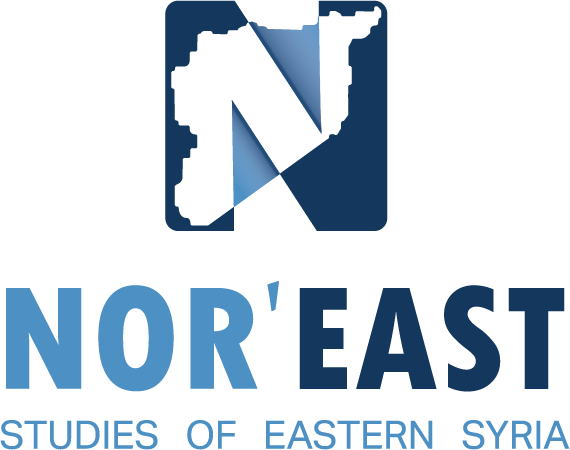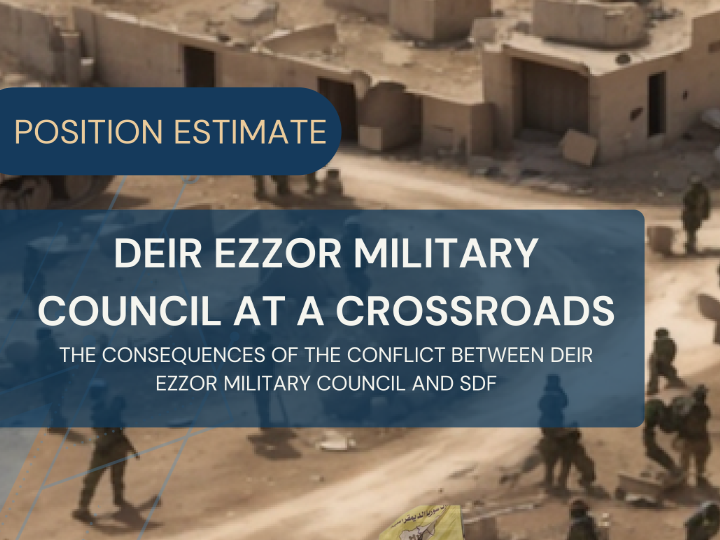Deir Ezzor Military Council at a crossroads
East of the Euphrates witnessed a dispute between SDF Deir Ezzor Military Council (DMC) led by Ahmad al-Khabil on one hand, and SDF on the other, so that this dispute developed in the past few days into relatively large-scale military clashes that included the northern countryside of Deir Ezzor. Moreover, some of the region’s tribes joined the clashes,
This paper will look for causes and repercussions of the dispute, furthermore, what are the possible scenarios for the relationship between the two parties? Then How did the tribe affiliation of DMC affect the conflict between the two parties?
root causes of the conflict:
Recently, there has been an increased discussion about the deployment of crowds sent by the coalition forces to the eastern areas of Deir Ezzor. This coincides with meetings between the coalition and representatives of the military councils and factions from the Arab component east of the Euphrates, as a prelude to an anticipated military operation in Al-Bukamal. In the same context, other rumors have circulated about potential changes in the military structure of the Deir Ezzor Military Council, which may also involve its commander, Ahmed Al-Khabil. Al-Khabil, in turn, has sparked a lot of controversy through leaked audio recordings containing in which he insulted the sheikhs of Al-Akidat tribe.
It is worth noting here that the roots of the disputes between al-Khabil and some sheikhs of Al-Akidat tribe from al-Hafel family trace back to al-Khabil’s attempt to declare himself as the Emir of Zabid tribes. This was based on statements and declarations issued by several Zabid dignitaries in Syria and abroad, affirming their allegiance to al-Khabil and pledging loyalty to him as the Emir of Zabid tribes in general. These statements provoked the historical sheikhdom of Al-Akidat tribe, represented by al-Hafel family, who opposed al-Khabil’s attempt to surpass them and declare himself as the Emir of Zabid tribes.
Given that al-Bakir tribe itself is a branch of Al-Akidat tribe, which, in turn, is one of the major branches of greater Zabid tribe, it was Sheikh Jamil al-Hafel and the sons of Khalil al-Hafel, namely Sheikh Musa’ab and Sheikh Ibrahim, who stood at the forefront of those objecting to al-Khabil.
Afterward, a serious development occurred, represented by the targeting of Sheikh Jamil al-Hafel’s house by unknown armed individuals in Al-Muweileh in al-Sour district on the tenth of July. Although Sheikh Jamil al-Hafel did not publicly accuse any party, the name of Ahmed al-Khabil circulated within al-Hafel family on a limited scale. What further complicated the matter was Sheikh Jamil al-Hafel’s absence from two social occasions that al-Khabil invited him to, whereas Jamil had never been absent from such occasions in the past.
Subsequently, there was an exchange of accusations between supporters of both parties on social media which escalated to the point where even Abu Khawla himself directed insults at some tribal figures from al-Hafel. In an effort to resolve the escalating dispute, within the ranks of SDF a wide scale meeting was held in Al-Hasakah just days before the recent developments, between DMC leaders and SDF, including several personnel from the People’s Protection Units (YPG) to resolve the escalating tensions between the two sides.
Following this, another meeting was held at the house of Awad Hussun al-Shallal in al-Sour district, attended by prominent figures from al-Bakir tribe. Additionally, there was a private meeting between Mazloum Abdi and Ahmed al-Khabil.
Region’s landscape before the recent developments:
The contact lines in Deir Ezzor Governorate, situated on both banks of the Euphrates River, witnessed a state of cautious anticipation. Subsequently, there were significant military reinforcements observed on one hand with SDF, and on the other hand with the regime and Iranian militias. This came in response to rumors of an imminent military operation of international coalition targeting the Iranian militias, in which Arab component ‘s support is crucial especially in that geographical area which is considered distant from SDF’s military strength.
in turn, SDF dealt with the issue with great caution, it consistently tries to stay as a unified military umbrella for all military coalition allies and it didn’t allow to any fiction to surpass or undermine its authority. Through this approach, SDF sought to monopolize the political negotiation with Syrian and international actors in alignment with its vision of AANES.
Al-Khabil, over the past years, has built a network of balances between himself, local military leaders, and influential figures in the region aligned with him. This interconnected system has granted him dominance over the war economy, like oil, and has given him control over the security situation in a manner that makes it difficult for all actors in the area to dispense with him.
In case al-Khabil was laid off, the web of connections that al-Khabil has established makes dealing with the void he leaves behind a complex challenge. However, the position al-Khabil has carved out for himself brought along negative consequences, as it has led him to treat his tribe and the surrounding tribes with a kind of authoritarianism that provoked many of them.
Reasons and motives for the clashes:
The primary motive behind the escalation initiated by DMC, led by Ahmed al-Khabil, could be his perception of potential changes that the coalition might implement regarding the military representation of the Arab component. However, it is essential to acknowledge that there are other underlying reasons that have complicated the situation and hastened the confrontation.
One such reason is the SDF’s fear of al-Khabil ‘s growing social authority, which extended beyond regional boundaries with his self-proclamation as the Emir of Zabid tribes. Such claim in which he harnessed all his financial and moral resources, which elevated his status and influence in the region.
A significant concern for SDF is the possibility of al-Khabil directly connect with the coalition, bypassing SDF, and his willingness to engage in any military operation, even if it involves confronting Iranian militias. This is evident in the deliberate leaking of audio recordings where al-Khabil portrays himself as a revolutionary figure capable of mobilizing the displaced anti-regime fighters from the west to the east of the Euphrates.
Notably, DMC includes a considerable number of former opposition fighters who remained in the region and found no better option. This potential direct relationship with the coalition could place al-Khabil in a future negotiation position, implying a partial undermining of SDF’s authority.
Furthermore, This implies that al-Khabil transitioned into a political role that potentially undermines SDF authority even if only partially. Especially considering the channels between al-Khabil and Assad regime, facilitated by intermediaries involved in oil smuggling between the two banks of the Euphrates.
Details and course of military developments:
SDF military police intercepted a group of DMC forces to the north of Al-Sour in the northern countryside. The situation escalated into clashes between the two parties, resulting in the death of two members from the commandos forces, also known as the “elite” forces in the council. The deceased individuals belonged to al-Bakir tribe, to which Ahmed al-Khabil belongs.
As a result, the leadership of DMC in al-Sour Square gave a deadline to the military police to release the member it had arrested, before it began its attack, which extended to include several areas, including al-Sabha, Al-Busira, and Al-Rabida. During this aggression, DMC forces extended their control over the areas from al-Sour to al-Busira and al-Izbah, even crossing the Hasakah-Deir Ezzor road. They received support from some tribesmen who also participated in pro-Khabil demonstrations in Gharanij.
The clashes were accompanied by aerial sorties of coalition aircraft in the region’s skies. Recorded footage showed members of the Deir Ezzor Military Council capturing a group of military police personnel during the confrontations. Eventually, Kurdish cadres and SDF members withdrew from their positions in the villages of the eastern countryside and north of Deir Ezzor. However, relative calm was restored after the intervention of the coalition and al-Khabil’s call to his forces in audio recordings to cease fire and seek de-escalation.
The effect of the event on each of the actors:
Undoubtedly, after the recent developments, DMC successfully conveyed its credentials to the international coalition and positioned itself as a formidable player in the region, difficult to ignore in any project. The council has also managed to weaken the influence of Kurdish SDF caders in its sector and gain increased support from the local tribal population.
Simultaneously, the Council put itself under threat in the event that the consultations did not take place as it wanted, as the tables might turn against it with the support of the international coalition.
The coalition’s policy during the ongoing confrontations was to not intervene in favor of either side. This was in order to maintain control over the situation to prevent it from escalation into chaos. The coalition closely monitored the capabilities of both sides to mobilize and manage the battle before intervening to calm the situation and defuse the conflict.
As for SDF, it was the most affected by the events, and its authority has diminished after the recent developments, unlike its previous position. It appeared as a party in conflict rather than a ruling authority in this battle, which represented a balance of power and a show of strength. It also revealed that SDF’s influence in Deir Ezzor largely relies on local forces that have the capability to control the tribes in the region. Those tribes although feel dissatisfaction with DMC, they prefer to align with any local power against the SDF which is coming from outside the region, in their view.
Regarding the regime and its allies, they were among the most benefited from the events. The disagreements that occurred highlighted the militia-like nature of the factions associated with the coalition, which strengthened the narrative of the regime about SDF and the coalition. These divisions and clashes will likely delay any potential military action against areas under the regime’s control.
As for ISIS in the region, it was waiting for such chaos since the SDF took control of the area. This has provided them with a temporary margin to maneuver and support their cells and members logistically. Thus, it may increase the pace of their operations in the future, taking advantage of the unstable security conditions.
In Deir Ezzor, the Arab military factions displayed varied positions. Hajin Military Council, for instance, maintained its alignment with SDF central command, opposing all acts of strife. On the other hand, al-Shuaitat Military Brigades expressed their support for the Council during the recent events.
Scenarios and repercussions of the event:
Scenario 1: Success of the ceasefire between the two parties, based on the alliance’s interest in maintaining relative stability in the region amid the continuous ISIS threat, and the alliance’s intention to pursue projects west of the Euphrates without being distracted by internal conflicts. Therefore, the alliance intervened from the beginning of the clashes, pressuring both sides to reach a comprehensive ceasefire that would restore the region to its pre-existing state before the recent events. This implies that a consensus formula will likely be reached with al-Khabil while keeping the Deir Ezzor Military Council intact.
Scenario 2: A temporary relative ceasefire, which involves halting military operations between the two parties, while the underlying conflict continues. This conflict may manifest in the form of targeted assassinations, either directly conducted by SDF against al-Khabil or by unknown actors. Another possibility is the dissolution of DMC and replacing it with an Arab military body loyal to SDF, exploiting the tribal resentment towards the practices of the military council.
The third scenario involves al-Khabil seeking to maintain a state of tension and mobilization at its peak, with the intention of using it at any time to create confusion and reignite tensions if necessary. The ultimate goal is to reach an agreement with the Coalition to grant al-Khabil full authority over the region extending from al-Sour to al-Busairah, including the seven villages under regime control. This strategy is pursued, especially since al-Khabil is aware that the Coalition is currently unable to find a suitable alternative that would safeguard its interests in the turbulent region.
No doubt, the region remains unstable in eastern Euphrates, and the coming days will likely witness various developments that may reshape the region after the erosion of trust between SDF and DMC. Until then, the people in the area will continue to experience a state of dispersion and instability.







